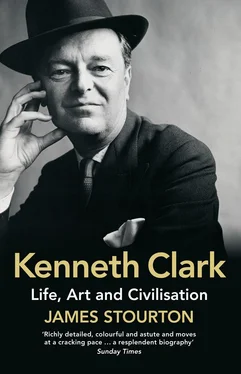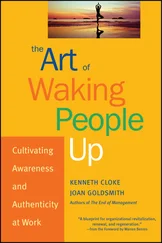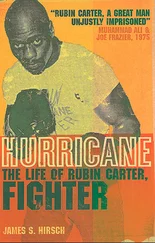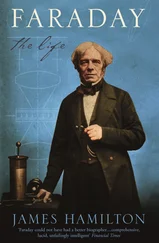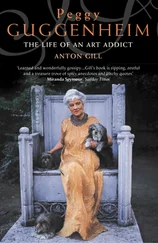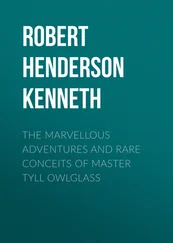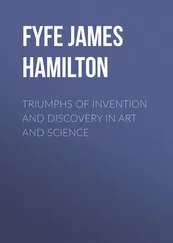A word on nomenclature: Clark was always known as ‘K’ by family and friends. In 1938 he became Sir Kenneth Clark, and in 1969 he was given a peerage and became Lord Clark of Saltwood – but I refer to him throughout as ‘Clark’.
Clark studies will continue to produce new interpretations and information. This work must be seen as ‘notes towards a definition’ – space restricted me on nearly every subject covered – and it should be taken as an encouragement to other scholars to investigate his life and achievements further.
JAMES STOURTON
London, 2016
Everything about Lord Clark is unexpected.
ANTHONY POWELL, reviewing Another Part of the Wood 1
At 12 noon on Sunday, 25 March 1934, King George V and Queen Mary climbed the steps of the National Gallery in London. It was the first time a reigning monarch had visited the gallery. The ostensible reason for the visit was to see the gallery’s collection of paintings, but the real purpose was to meet the new thirty-year-old director, Kenneth Clark. The trustees had been told not to disturb their weekend – a gentle instruction that their presence was not required – the King wished to see the director. Clark had only been at the gallery for three months, and his appointment had been greeted with universal approval – except at Windsor Castle. The King and Queen had been advised two years earlier by Owen Morshead, the Royal Librarian, that Clark would be the perfect candidate for the anticipated vacancy of Surveyor of the King’s Pictures. But Clark neither wanted the job nor felt that he could possibly combine it with his heavy duties as director of the National Gallery. The sixty-nine-year-old King Emperor, in an extraordinary move, decided that he would directly intervene and go down to Trafalgar Square to invite the young man to work for him. He had resolved that Clark was the man he wanted, and where his courtiers had failed, he would persuade him personally. The visit was a success, and the two men – as different as can be – found much to enjoy together. Clark later described how just after proclaiming that Turner was mad, the King ‘stopped his routine progress, faced me and said’:
‘Why won’t you come and work for me?’
‘Because I wouldn’t have time to do the job properly.’
The King snorted with benevolent rage: ‘What is there to do?’
‘Well, sir, the pictures need looking after.’
‘There’s nothing wrong with them.’
‘And people write letters asking for information about them.’
‘Don’t answer them. I want you to take the job. ’2
There is no other recorded occasion of George V making such an effort – for instance, he never visited Downing Street – let alone for a thirty-year-old aesthete whose interests were as far as can be imagined from those of a gruff, pheasant-shooting, philistine sailor King. What was it about Kenneth Clark that made him so ardent? Clark had already had a similar effect on a series of distinguished elders, who all seem to have believed that they had discovered him: Monty Rendall, his headmaster at Winchester; Charles Bell, the keeper at the Ashmolean Museum at Oxford; Maurice Bowra, the Warden of Wadham College; Bernard Berenson, the most famous connoisseur in the world; and Sir Philip Sassoon, the chairman of the National Gallery. He was a Wunderkind from a brilliant generation of Oxford undergraduates; everybody recognised from the beginning that he would achieve great things (so often a recipe for lassitude in later life). Intelligence, charm and charisma played an important part in his story, but he was not alone in possessing these. What set him apart was his focus and complete absorption in art at a time when – artists aside – this was a singular quality. And he brought to this absorption an unusually synthetic power of analysis, expressed in a supple prose style that was able to fuse thought and feeling.
Early in life Clark discovered a sensibility to works of beauty: ‘Ever since I can remember, that is to say from about the age of seven, the combination of certain words, or sounds or forms has given me a peculiar pleasure, unlike anything else in my experience.’3 He called it ‘a freak aptitude’, and told a friend, ‘What is certain is that without it I would have been no more than an obscure and timid playboy.’4 This love of art in all its forms sustained him, and in one of the characteristically teasing yet self-revealing passages of his autobiography he remarked: ‘A strong, catholic approach to works of art is like a comfortable Swiss Bank … I never doubted the infallibility of my judgements … This almost insane self-confidence lasted until a few years ago, and the odd thing is how many people have accepted my judgements. My whole life has been a harmless confidence trick.’5 The confidence of youth was followed by the doubt of age.
Self-doubt is the last quality that anybody meeting Clark for the first time would have suspected. Most people were terrified of him and feared being snubbed, an attitude that baffled Clark himself, who was always expected to be one thing but was invariably something else. A folklore grew up around him – ‘impossibly, implausibly, supernaturally debonair’; ‘delicately poised between diffidence and disdain’; ‘a tranquil ruthlessness’; ‘he measured people and turned on an appropriate amount of charm’ – were all opinions offered about Clark. Most descriptions refer back to his solitary and protected childhood. His introversion suggested to many that he possessed no ‘radar’, or much perception of other people’s feelings; he could appear self-absorbed, and often cut people without even realising it. Yet those who worked for him – cooks and secretaries adored him – found him easy, and even cosy. There was a private Clark and a public Clark, one funny and warm, the other formal.
As Anthony Powell suggested, everything about Clark was surprising – he might have added contradictory and paradoxical: the writer who loved action, the scholar who became a populariser, the socialist who lived in a castle, the committee man who despised the establishment, the indefatigable self-deprecator whom many found arrogant, the shy man who loved monsters, the ‘ruthless’ man who hated confrontation, the brilliantly successful man who considered himself as a failure, the mandarin who had a passion for lemonade and ice cream. The impenetrably smooth performer had a highly emotional side, weeping in front of works of art and subject to spiritual and religious experiences. Graham Sutherland, who knew him as well as anybody, and lived in his house during the war, said: ‘of course K is a divided man … & of all my friends the most complex’. Behind all this was a mania for independence – never wishing to be caught or identified with any group except artists. As one confidante put it, ‘He was nervous of contamination.’6
There are many Kenneth Clarks to describe: the museum director, the courtier, the darling of society, the Leonardo expert, the man of action, the wartime publicist, the would-be contemplative scholar, the lecturer and journalist, the administrator and the professor, the television mogul and performer, the public intellectual, the non-academic art historian, the collector, the patron, the committee man, the conservationist, the family man and the lover – the sum of the man is equal to the parts. Describing Clark’s apparently detached progress through life, his younger son Colin thought that parents, schooling, wife, child and art all just flowed by like interesting scenery, and his father was scarcely aware that ‘there were other human beings on the planet until he was about twenty-eight years old’.7 Worldly or unworldly, Clark expected to go onto boards and for women to fall in love with him. It did not seem odd to him that he was offered the chairmanship of the Independent Television board without ever having owned a television.
Читать дальше
